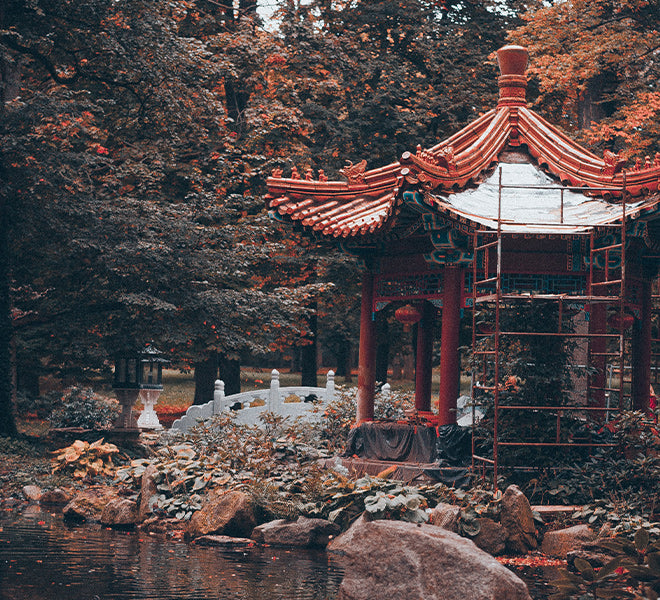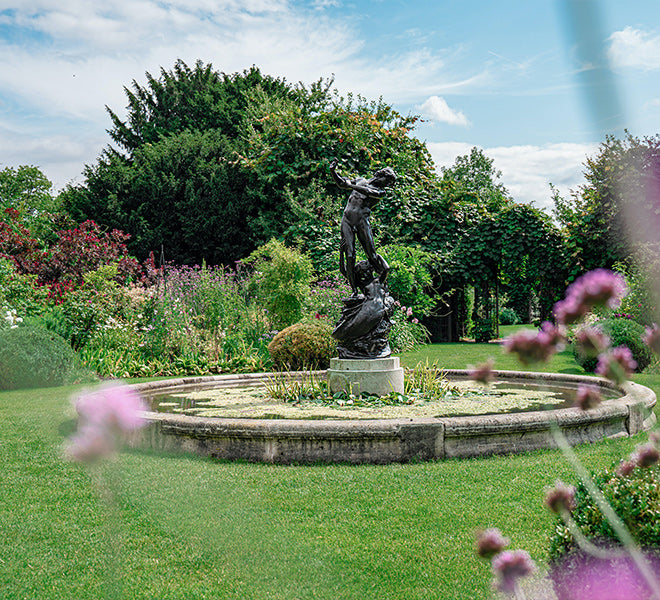Natural beauty is the common pursuit of garden art in different countries and nationalities, but there are significant differences in the understanding of natural beauty among the nationalities. Garden is a kind of recreational environment and material carrier created by people to yearn for nature and pursue the most beautiful life. It allows people to know nature and enjoy modern science and technology. Compared with the Western geometric garden and Chinese landscape garden, the first visual status of the two is the biggest difference in the shape of "curved and straight".
Origin of formation of "curved and straight"
Chinese classical gardens, also known as natural landscape gardens, are carefully designed with diverse means of architecture, plants, and landscape in a certain space to create a sense of beauty that comes from nature and is higher than nature. It can be divided into royal gardens and private gardens. Royal gardens are mostly built by the emperors and nobles, with tall and solemn layouts and majestic and magnificent styles, such as the Yuanmingyuan. Private homes are mostly built by the literati, they love the landscape, the pursuit of their ideals in nature, hoping to achieve a unity with nature, the style and layout of the garden is more natural. Such as the Humble Administrator's Garden, Canglang Pavilion layout compact and ingenious, style, and strive for the pleasure of winding paths. The layout is in a more natural state. No matter what kind of gardens are pursued to be closer to nature, the natural beauty will be fully reflected.
Although Made by Man, Just From Heaven
✔There is no fixed way to create Chinese gardens, but there are fixed rules, that is, "although made by man, just from heaven". All the elements of the landscape should be in harmony with the natural environment, in line with the laws of nature, Chinese gardens combine natural beauty and artificial beauty. Western gardens mainly reflect the power of man to change nature, create beauty based on mathematical laws, pay more attention to the study and analysis of human nature, and emphasize strong visual experience.🏡
✔Western classical gardens advocate openness in their garden layout, presenting a symmetrical and neat pattern that expresses the power of man to transform and control nature in an artificially beautiful way. Its geometric pattern is piled up by a central axis, with straight boulevards, neat ponds, magnificent sculptures and fountains, and magnificent buildings. Its layout is enormous, reflecting the grandeur of the kingdom. The central axis is flanked by groves with varying views, uniform fountain pools, plants, paths and water pans designed to achieve overall unity.🏞️

The origin of the classical Eastern garden design "curved"
Chinese gardening art has a long history, as early as the period of King Wen of the Zhou Dynasty on the construction of palaces and gardens, to the period of the Wei, Jin and North and South Dynasties, the initial establishment of the basic principles of reproduction of natural landscapes, the garden mainly as ornamental art to treat. To the Sui and Tang dynasties to gardening and poetry and painting, Chinese gardens created a realm of poetry and painting. The ancient Chinese people pursued the harmony and unity of man and nature, and their garden forms pursued the beauty of natural curves, creating natural landscape gardens, whether from building site selection, road design, or plant selection, the form of a large number of curves, making the garden winding paths, interesting. Its garden landscape is "curved" to show the characteristics of subtlety and introversion.
Gardening ideas
Taoism and Confucianism advocate nature, love of nature, the idea of "the unity of heaven and man" prompted people to pursue harmony with nature, the people and everything in heaven and earth as one inseparable, their philosophical thinking in the spirit of harmony between man and nature, the pursuit of the original natural beauty of the curve of the landscape, the artificial creation and the natural truth cleverly combined to create The natural and subtle natural landscape with curved paths, allowing people to return to the natural feeling. Thus, in the natural existence of things really natural "curve" form of the gardeners used to express the artistic mood. Under the influence of painting and poetry, classical Chinese gardens appreciate the beauty of natural curves, respect nature, and reflect the beauty of indifference and seclusion.


The Origin of "Straight" in Western Garden Design
Western gardens developed early with a unique aesthetic and gardening concept in the form of atrium layout. In the Middle Ages, Christian-related monasteries had cloister-style atriums. During the Renaissance, Italian terrace gardens became popular, which were built on a hill, with a clear central axis running through the garden and geometric planting. After the transfer to France, under the influence of mathematical aesthetic thought, rigorously developed in accordance with the pure geometric structure and mathematical relationships, the pursuit of geometric and patterned garden layout. The plants were still geometric and paths were as the linear forms. Believing in the philosophical view of "the opposition between heaven and man and the transformation of nature," the straight line was highly revered in lines of the forms. Because they believed straight line represented the will of man and considered straight line and geometric forms as beautiful forms.
Gardening ideas
The idea of gardening in Western garden design can be traced back to the ancient Egyptian and Greek periods when the environment was harsh and people demonstrated the great power of human beings in the struggle with the environment in order to live. The construction of Western gardens reflects the courage and spirit of people fighting against the natural environment in order to live, and they worship the power of artificial transformation. Under the background of the philosophical concept of "the opposition of heaven and man and the transformation of nature", the design of gardens is concerned with formal beauty and a sense of order, and they worship the beauty of straight lines, and make extensive use of straight lines and geometric shapes in the design of gardens and roads to meet people's level of appreciation for artistic beauty and to reflect the great power of human beings to conquer nature.

Roads in Western gardens are full of rationalism, with straight and spacious avenues forming a patterned plan layout throughout the garden. There are main roads that connect the buildings and secondary roads that branch off and combine with the landscape to form a variety of different geometric patterns, which also function as buildings and attractions. The "straight line" beauty of straight roads. In gardens are generally pruned into regular shapes plants and flowers, the street trees are neatly arranged on both sides of the straight roads, and mostly geometrically shaped, showing the power of artificial transformation of garden art. The design of the gardens is based on the massive buildings that form the main axis of the gardens. In order to make a better combination of plant landscape and architecture, a harmonious and unified effect is produced. The masonry of the building is more simple and geometric.
In this era of increasingly developed information, technology and new materials. We all need to be close to nature and enjoy it. Western gardens focus more on their courage and spirit to conquer nature, reflecting artificial beauty and designing more regular geometric and linear shapes. Turning the garden into a practical and economical place, pasture, planting of fruits and vegetables, etc. have become the functions of the British garden. Nowadays, the design of flower beds, plants, sculptures and garden squares in social gardens tends to be geometric, and the main paths in gardens or the main paths into gardens are more inclined to the straight and open of Western gardens. Most of the small garden paths in the landscape still show the natural curvature of classical Chinese gardens, and the selection of plants also tries to choose native plants, still retaining the curved, natural forest canopy margins that characterize the "curves" of classical Chinese gardens.











